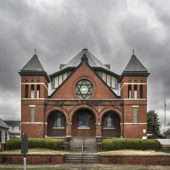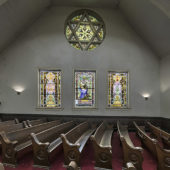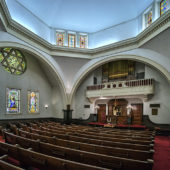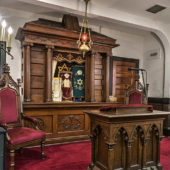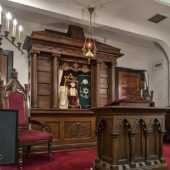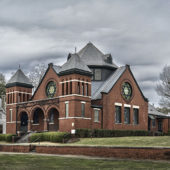One of the few continuously used synagogues in the United States constructed before the 20th Century.
Temple Mishkan Israel was completed in December 1899 and dedicated in February 1900. It is one of only about 20 pre-1900 synagogues in the United States that is still in active use as a synagogue. The building is a two-story, Romanesque Revival structure with two symmetrical towers and a raised octagonal roofed sanctuary. There are large Mogen David stained glass windows above the arched entry and on the building’s arched sides.
The first Jews came to Selma in the 1830s. They were itinerant merchants of Sephardic ancestry who had emigrated to the West Indies and thence to port cities such as Charleston, Mobile and New Orleans. A decade later Ashkenazi Jews from Western Europe began arriving and later, in the 1880s, Eastern European Jewish immigrants who had entered the United States through northeastern ports came to Selma. For more than a century Selma’s mercantile activity was dominated by Jewish merchants including Teppers, Kaysers, Liepolds, Rothchilds, Adler Furniture, Benish and Meyer Tobacco, Siegel Automobile Company, Barton’s Bargain Store, Bendersky’s and Eagles. Jews figured importantly in civic affairs and local government with three of the city’s mayors being Jewish.
In contrast to its dominance in the business community, the Jewish population of Selma was never large, peaking at about 325 on the eve of World War II. Selma’s fortunes have declined as cotton is no longer king, nor even a prince. As economic opportunity dried up, the Jewish population shrank and today there are only ten Jews remaining, the youngest nearly 60 years old.

